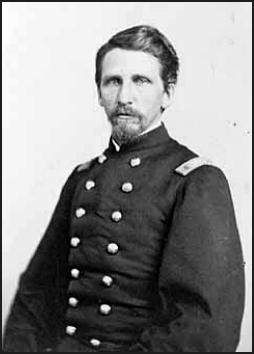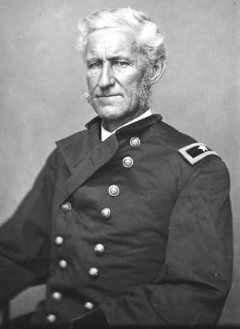Since the majority of the Civil War occurred EAST of the Mississippi River, one might think that the last battle happened there as well, but such is not the case. Of record, the last battle of the Civil War occurred on May 12 -13, 1865 in an obscure area of SOUTHEAST TEXAS not far from Brownsville. It was called the Battle of Palmetto Ranch and depending on one’s perspective it was a Confederate victory or a successful Union raid that culminated in a tactical withdraw. Very little is known or was written about this battle and the two “Union” after action reports are all that appear in Vol. 48 of the Official Records of the War of the Rebellion Pages 265 – 269 and one of these reports is as follows:
Headquarters Third Brigade, 1st Div., 25th Army Corps,
Camp near Brownsville, Tex., August 10, 1865.
General: I have the honor to submit the following report of the action at Palmetto Ranch, Texas, May 13, 1865, the “last engagement of the war.”
|

Colonel Theodore H Barrett
|
On the evening of May 11, 1865 an expedition consisting of 250 men of the Sixty-Second U. S. Colored Infantry, properly officered and fifty men and two officers of the Second Texas Cavalry (not yet mounted), the whole command under Lieutenant Colonel Branson of the 62 U. S. Colored Infantry, was sent by me, then commanding the forces at Brazos Santiago, Texas from the island to the mainland. Crossing the Boca Chica which owing to a severe storm was effected with difficulty, the forces marched nearly all night and after a short rest early the next morning attacked a strong outpost of the Rebels at Palmetto Ranch, Texas on the banks of the Rio Grande.
The enemy was driven in confusion from his position, his camp, camp equipage, and stores falling in our hands. Some horses and cattle were also captured and a number of prisoners were taken. Destroying such stores as could not be transported, Lieutenant Colonel Branson returned to the vicinity of White’s Ranch and took up his position for the night. On the morning of the 13th about 200 men of the 34th Indiana Veteran volunteer Infantry under Lieutenant Colonel Morrison joined Lieutenant Colonel Bronson.
Assuming command in person of the forces thus united, I ordered an advance again to be made in the direction of Palmetto Ranch which upon the retirement of Lieutenant colonel Bronson had been re-occupied by the Rebels. The enemy’s Cavalry were soon encountered. Driving them before us, we reached the ranch by 7 or 8 a.m., and again compelled the Rebels to abandon it. Such stores as had escaped destruction the day previous were now destroyed and the buildings which the enemy had turned into barracks were burned, in order that they might no longer furnish him convenient shelter. A detachment was here sent back to Brazos Santiago with our wounded and the prisoners and captures of the day previous. The remainder of the forces were ordered to advance. Nearly the entire afternoon 9May 13) was spent in skirmishing. The enemy, though taking advantage of every favorable position, was everywhere easily driven back. Early in the afternoon a sharp engagement took place, which being in the chaparral, was attended with comparatively little loss to us.
In this engagement our forces charged the enemy, compelled him to abandon his cover and pursuing him, drove him across an open prairie beyond the rising ground completely out of sight. The enemy having been driven several miles since daylight and our men needing rest, it was not deemed prudent to advance farther. Therefore, relinquishing the pursuit, we returned to a hill about a mile from Palmetto Ranch, where the 34th Indiana had already taken its position. About 4 p.m. the Rebels, now largely reinforced, again reappeared in our front, opening fire upon us with both artillery and small arms. At the same time a heavy body of Cavalry and a section battery under cover of the thick chaparral on our right, had already succeeded in flanking us with the evident intention of gaining our rear. With the Rio Grande on our left, a superior force of the enemy in front and his flanking force on our right, our situation at this time was extremely critical. Having no artillery to oppose the enemy’s six 12 pounder field pieces our position became untenable.
We therefore fell back fighting. This movement, always difficult, was doubly so at this time having to be performed under a heavy fire from both front & flank. Forty- eight men of the 34th Indiana Veteran Volunteer Infantry, under Captain Templer, put out as skirmishers to cover their regiment, were while stubbornly resisting the enemy, cut off and captured by the enemy cavalry. The 62nd U. S. Colored Infantry being ordered to cover our forces while falling back, over half of that regiment were deployed as skirmishers, the remainder acting as their support. This skirmish line was nearly three quarters of a mile in length and reaching from the river bank, was so extended as to protect our front and right flank. Every attempt of the enemy’s cavalry to break this line was repulsed with loss to him and the entire regiment fell back with precision and in perfect order, under circumstances that would have tested the discipline of the best troops. Seizing upon every advantageous position, the enemy’s fire was returned deliberately and with effect. The fighting continued three hours.
|

Maj. General Lorenzo Thomas
|
The “LAST VOLLEY of the WAR”, it is believed was fired by the 62nd U. S. Colored Infantry about SUNSET on the 13th of MAY, 1865, between White’s Ranch and the Boca Chica, Texas. Our entire loss in killed, wounded and captured was 4 officers and 111 men. IN several instances our men were fired upon from the Mexican side of the Rio Grande. Upon occupation of Brownsville a few days later it was reported, upon what appeared to be good authority, that during the engagement a body of Imperial [Mexican] Cavalry crossed the Rio Grande from Matamoras to Brownsville, doubtless with a view of adding the Rebels.
Reports in detail of this action were forwarded to Departmental headquarters at New Orleans shortly after the engagement took place. As these reports may have never reached the Adjutant General’s Office, the fore going statement of the last actual conflict between hostile forces in the great rebellion is respectfully submitted.
I am, General, with high respect, your most obedient servant,
Theodore H. Barrett, Colonel Sixty Second U. S. Colored Infantry.
To: Major General L. Thomas, Adjutant General, U. S. Army
Now then, since this was the last battle of the Civil War, who was victorious? Since the Confederate forces occupied the battlefield after the battle it has been construed as a Confederate victory because normally during the Civil War whoever occupied the battlefield after the battle was considered the victor. However, if one was of the “Northern Persuasion” this can be construed as a successful expedition or raid that resulted in the destruction of a Confederate supply post that was Palmetto Ranch and terminated in a successful defense against an overwhelming enemy force as it returned to the safety of its’ Union Camp. Also, other Confederate forces west of the Mississippi River had not surrendered and many of the BUSHWHACKERS in Missouri continued to fight and of course here in the Trans-Mississippi the war still went on!